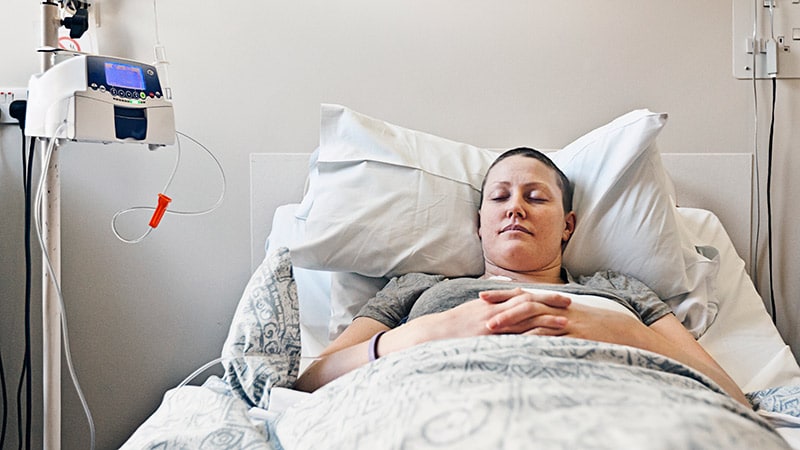Younger Breast Cancer Survivors with Genetic Variants or In Situ Tumors Face Higher Risk of Second Primary Breast Cancer
Core Concepts
Younger breast cancer survivors with germline pathogenic variants or an initial diagnosis of in situ disease have a significantly higher risk of developing a second primary breast cancer.
Abstract
This study examined the risk factors for developing a second primary breast cancer among younger breast cancer survivors. The researchers evaluated a cohort of 685 patients diagnosed with stages 0-III breast cancer at age 40 or younger, as well as 547 younger women who had undergone bilateral mastectomy.
Key findings:
2.5% of the main cohort developed a second primary breast cancer over a median of 4.2 years.
Patients with a germline pathogenic variant had a fourfold higher risk of second primary breast cancer compared to non-carriers.
Patients initially diagnosed with in situ disease had over a fivefold higher risk compared to those with invasive disease.
The researchers found a low risk of contralateral breast cancer among women without pathogenic variants.
The authors conclude that genetic testing is important for younger breast cancer survivors to assess their risk of a second primary breast cancer. They also note that the higher risk among those with in situ primary tumors merits further investigation.
Certain Women May Face Higher Risk for Second Breast Cancer
Stats
Among the 685 main study participants, 17 (2.5%) developed a second primary breast cancer over a median of 4.2 years.
The 5-year and 10-year cumulative incidence of second primary breast cancer was 1.5% and 2.6%, respectively.
Patients with a germline pathogenic variant had a 5.5% risk of second primary breast cancer at 5 years and 8.9% at 10 years, compared to 1.3% and 2.2% for non-carriers.
Patients initially diagnosed with in situ disease had a 6.2% risk of second primary breast cancer at 5 years and 10.4% at 10 years, compared to 1.2% and 2.1% for those with invasive disease.
Quotes
"Overall, only 33 women were positive for a germline pathogenic variant, and having a pathogenic variant was associated with a fourfold higher risk for second primary breast cancer compared with noncarriers at 5 years (5.5% vs 1.3%) and at 10 years (8.9% vs 2.2%)."
"Patients initially diagnosed with in situ disease had more than a fivefold higher risk for second primary breast cancer compared with those initially diagnosed with invasive disease — 6.2% vs 1.2% at 5 years and 10.4% vs 2.1% at 10 years (hazard ratio, 5.25; P = .004)."
Key Insights Distilled From
by Deepa Varma at www.medscape.com 04-17-2024
https://www.medscape.com/viewarticle/certain-women-may-face-higher-risk-second-breast-cancer-2024a10007eo
Deeper Inquiries
What are the potential biological mechanisms underlying the increased risk of second primary breast cancer in younger survivors with genetic variants or in situ tumors?
Younger breast cancer survivors with genetic variants or in situ tumors may have an increased risk of developing a second primary breast cancer due to various biological mechanisms. Genetic variants, especially germline pathogenic variants like BRCA1 and BRCA2, are known to be associated with an elevated risk of breast cancer. These variants can lead to impaired DNA repair mechanisms, making individuals more susceptible to developing additional breast tumors. In the case of in situ tumors, where the cancer cells are confined to the ducts or lobules of the breast, there is a potential for these abnormal cells to progress to invasive cancer or for new primary tumors to develop. The presence of genetic variants or in situ tumors may create a microenvironment conducive to tumorigenesis, increasing the likelihood of a second primary breast cancer.
How can the findings of this study be used to inform personalized screening and prevention strategies for younger breast cancer survivors?
The findings of this study can significantly impact personalized screening and prevention strategies for younger breast cancer survivors. Identifying individuals with germline pathogenic variants through genetic testing can help stratify the risk of developing a second primary breast cancer. For those with pathogenic variants, more intensive surveillance strategies, such as frequent imaging and clinical exams, may be warranted to detect any new breast tumors at an early stage. Additionally, younger survivors initially diagnosed with in situ breast cancer should be closely monitored due to their higher risk of a second primary breast cancer. Tailoring screening protocols based on genetic status and initial diagnosis can improve early detection and potentially reduce morbidity and mortality in this population.
Given the low risk of contralateral breast cancer among women without pathogenic variants, what are the implications for surgical decision-making in this population?
The low risk of contralateral breast cancer among women without pathogenic variants has significant implications for surgical decision-making in this population. For individuals without genetic variants, the risk of developing a second primary breast cancer in the contralateral breast is relatively low. This information can guide discussions around the necessity of prophylactic contralateral mastectomy as a risk-reducing strategy. Surgical decisions should be made in a shared decision-making process between the patient and healthcare provider, considering individual risk factors, preferences, and the potential benefits and risks of surgery. The findings suggest that for women without pathogenic variants, surveillance and risk-reducing strategies other than contralateral mastectomy may be more appropriate, emphasizing the importance of personalized care in breast cancer management.
0
